2010 G20 Toronto summit
The fourth meeting of the G20 heads of state and government to talk about the world economy and the global banking system was held at the Metro Toronto Convention Center in Toronto, Ontario, Canada, on June 26 and 27 of that year. The main goals of the meeting were to look at how far financial reform has come, come up with long-term stimulus plans, talk about a global bank tax, and support open markets. Along with the twenty-one representatives of the G20 major economies, the meeting also included the leaders of six invited countries and eight other intergovernmental organizations.
| 2010 G20 Toronto Summit | |
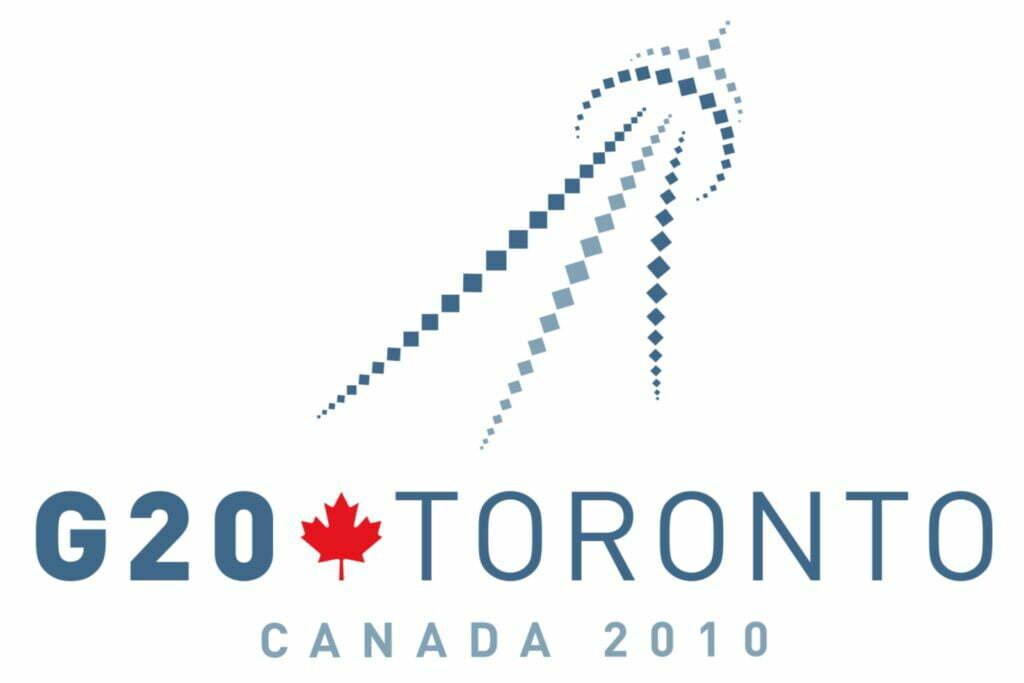 | |
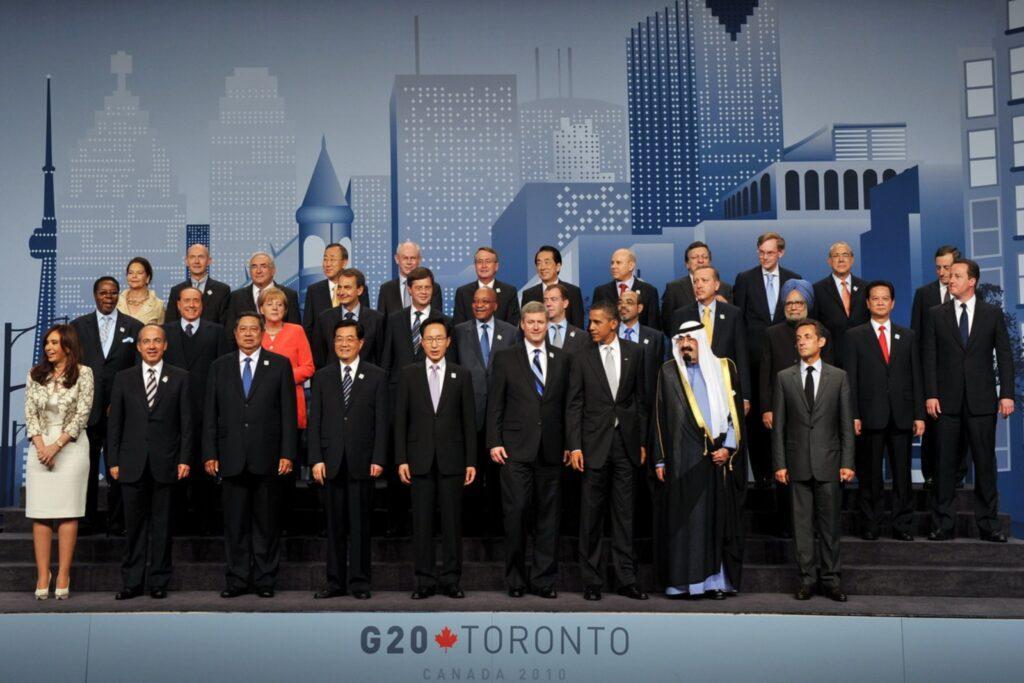 | |
| Host country | Canada |
| Date | June 26-27, 2010 |
| Venue (s) | Metro Toronto Convention Centre |
| Cities | Toronto, Ontario |
| Follows | 2009 G20 Petersburg Summit |
| Precedes | 2010 G20 Seoul Summit |
| Website | Official website |
Stephen Harper, the prime minister of Canada, revealed before the summit that the theme would be “recovery and new beginnings.” He was referring to the expected economic boost from the effects of the current global recession. Harper first suggested holding the meeting in Huntsville, Ontario, because that was where the 36th G8 summit was going to happen right after it. Later, organizers decided that the town wasn’t big enough to host all the G20 participants and reporters, so they chose Toronto instead.
To keep everyone safe during the summit in downtown Toronto, organizers put together an Integrated Security Unit with police officers from several area departments. Canadian history’s biggest and most expensive security effort included the event. A lot of people were wrongfully arrested, and some of them were held in horrible conditions. It was found that security, infrastructure, and hospitality for both the 36th G8 meeting in Huntsville and the G20 summit in Toronto added up to about C$858 million.
Agenda
It was unclear what topics would be tackled at the G20 conference, and several of the world’s top leaders had different ideas. The summit’s main topic was how to get out of the current worldwide recession and the European debt crisis. Leaders at the summit disagreed on the appropriate approach to take in order to solve these issues. Budget deficits were a major concern for the European Union, so austerity measures were prioritized. To spur growth, the United States, in contrast, has stressed the significance of continuing stimulus spending. European Union member states shared plans for future budget cuts and fiscal rectitude during a summit meeting. However, the United States, China, and India all called for more stimulus spending to lessen the impact of the recession. Both the United States and Canada were opposed to the European Union’s proposed global bank tax and Robin Hood tax. International aid to Africa and other developing nations, as well as other aspects of international development, were also major points of discussion. Some attendees voiced opposition to the siege of the Gaza Strip by Israel, while others spoke out against North Korea’s nuclear program and the United States’ handling of corruption and security concerns in Afghanistan.
Preparations
Security
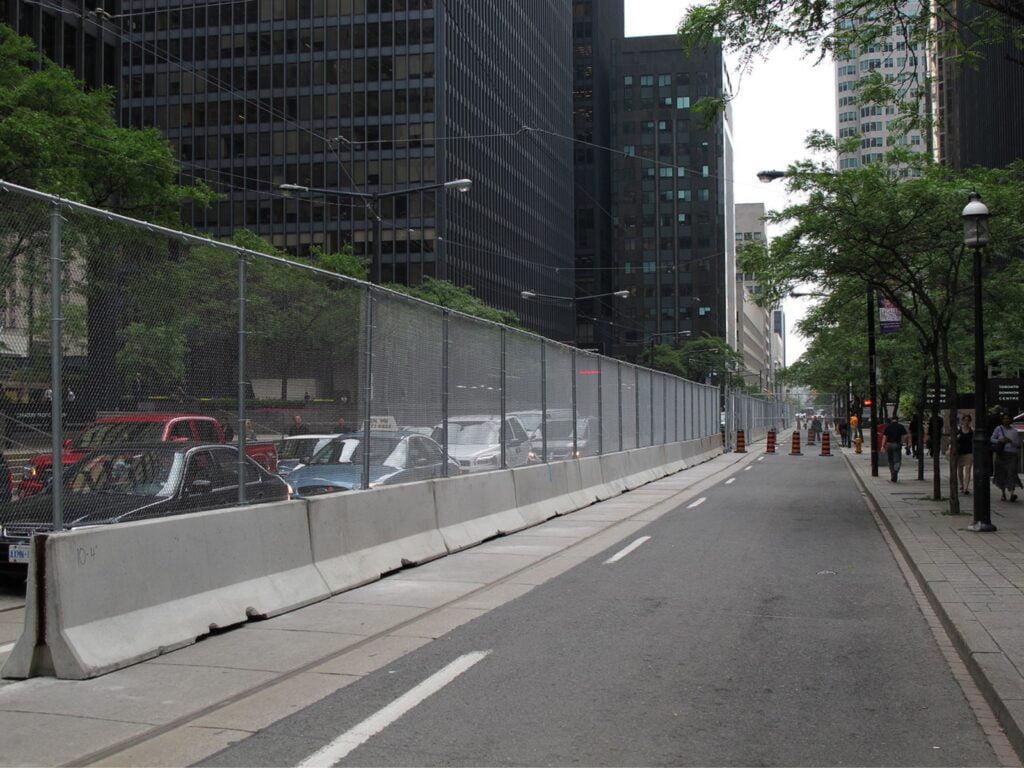
In February 2010, security leaders started getting ready for the meeting in Toronto. The Toronto Police Service, the Ontario Provincial Police, the Royal Canadian Mounted Police, and the Canadian Forces were in charge of general patrolling and police work. The Peel Regional Police helped with police work at Toronto Pearson International Airport outside of Mississauga when delegates arrived. In a way similar to the one made for the 2010 Winter Olympics in Vancouver, the five departments came together to make an Integrated Security Unit (ISU). The Greater Sudbury Police Service, the Waterloo Regional Police Service, the Niagara Regional Police Service, the Hamilton Police Service, the Ottawa Police Service, and the Service de Police de la Ville de Montréal all sent more officers to help. About a week before the meeting, the Calgary Police Service sent 150 volunteer police officers.
At the start of the summit, The Globe and Mail said that there would be 25,000 uniformed police officers, 1,000 security guards from Commissionaires Great Lakes, and a number of Canadian military troops. High-altitude CF-18 Hornet jets, CH-124 Sea Kings, and CH-146 Griffon helicopters were used by the North American Aerospace Defense Command (NORAD) for Amalgam Virgo drills on May 6 and 7. The exercises took place in the Greater Toronto Area. For both the G8 and G20 summits, security cost a total of $1.8 billion, which was paid for by the government’s Crown-in-Council. This does not include the costs of any damage that might have been done to local businesses.
During the summit times, vehicles would be limited inside the security perimeter set up by the ISU. The perimeter was bounded by King Street to the north, Lake Shore Boulevard to the south, Yonge Street to the east, and Spadina Avenue to the west. Pedestrians who wanted to enter the security zone could only do so at one of 38 checkpoints, where they had to show two forms of photo ID and explain why they were there. People who lived in the security zone were given registration cards before the summit. No one, not even protesters, could go into the area around the Metro Toronto Convention Center because it was blocked off. It cost $5.5 million to build, and two companies from Gormley, Ontario, started putting up the 3-meter (10-foot) high fence on June 7. Public Works and Government Services Canada hired SNC-Lavalin to do the work. Along with buying four long-range acoustic devices that would only be used during the meeting, the Toronto Police Service also put in 77 more closed-circuit television security cameras in the area. To stop the riots, the ISU also chose to use water cannons. A maritime security operation with many police boats and the Canadian Coast Guard ship Griffon patrolling the waters of Lake Ontario was part of the security perimeter. This was done to keep foreign protesters from coming into Canada illegally.
Infrastructure
People who were arrested during the meeting were put in a former movie studio on Eastern Avenue as a temporary custody center. The Toronto Police Service said that the protest area would be Trinity Bellwoods Park, but the protest area was moved to the northern part of Queen’s Park after neighbors complained. Within the security zone, Canada Post said it would be taking down the post boxes. Many parking meters were also taken away by the Toronto Parking Authority. Politicians couldn’t use the small trees that were planted along the streets around the convention center as weapons, so they were cut down. Seventy-five mailboxes, 200 public trash cans, 745 newspaper boxes, 29 bus stops, and five public information boards were also taken away by the city.
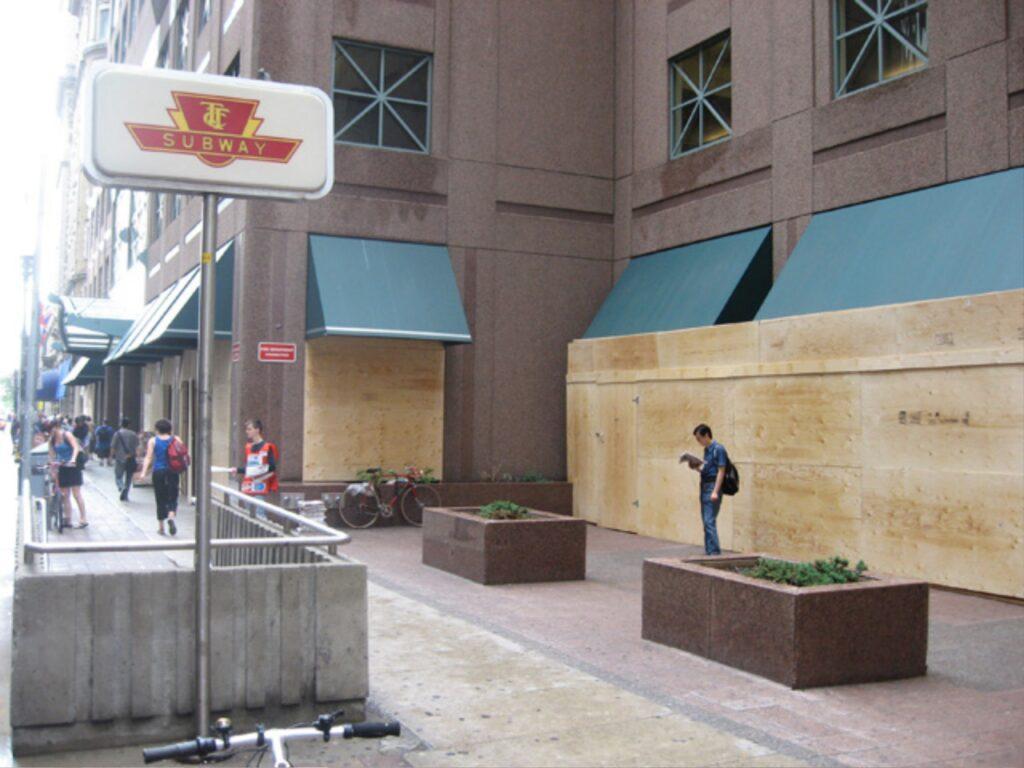
within a radius of 30 nautical miles (equivalent to 56 kilometers). Porter Airlines has been granted authorization to maintain its flights to and from Billy Bishop Toronto City Airport. The Toronto District School Board and Toronto Catholic District School Board terminated transportation services for six schools located in downtown Toronto on June 25, impacting a total of 45,000 students, including 10,000 who have physical disabilities.
A media center was set up by summit organizers specifically for international media people, journalists, and press reporters in the Direct Energy Center located at the Exhibition Place. A pavilion measuring 20,000 square feet (1,858 m2), known as Experience Canada or Canadian Corridor, was built by the Federal and Ontario governments in the media center. Its purpose is to globally promote Canadian tourism. The pavilion comprised three government-funded exhibits of life-sized proportions: Cityscape, which highlighted prosperous Canadian businesses and advancements; The Bridge, which featured information kiosks for media personnel and large high-definition screens broadcasting the 2010 FIFA World Cup matches; and Northern Ontario Oasis, an artificial lakefront inspired by the cottage country of the Muskoka region. The Northern Ontario Oasis included donated boats, a coastline equipped with deck chairs for journalists to refresh themselves, and a cell phone recharging station. The backdrop consisted of a sizable display showcasing many photographs of the Muskoka region. The international media center, the Experience Canada pavilion, and the artificial lake incurred costs of $23 million, $1.9 million, and $57,000, respectively, and became the subject of controversies.
Attendance
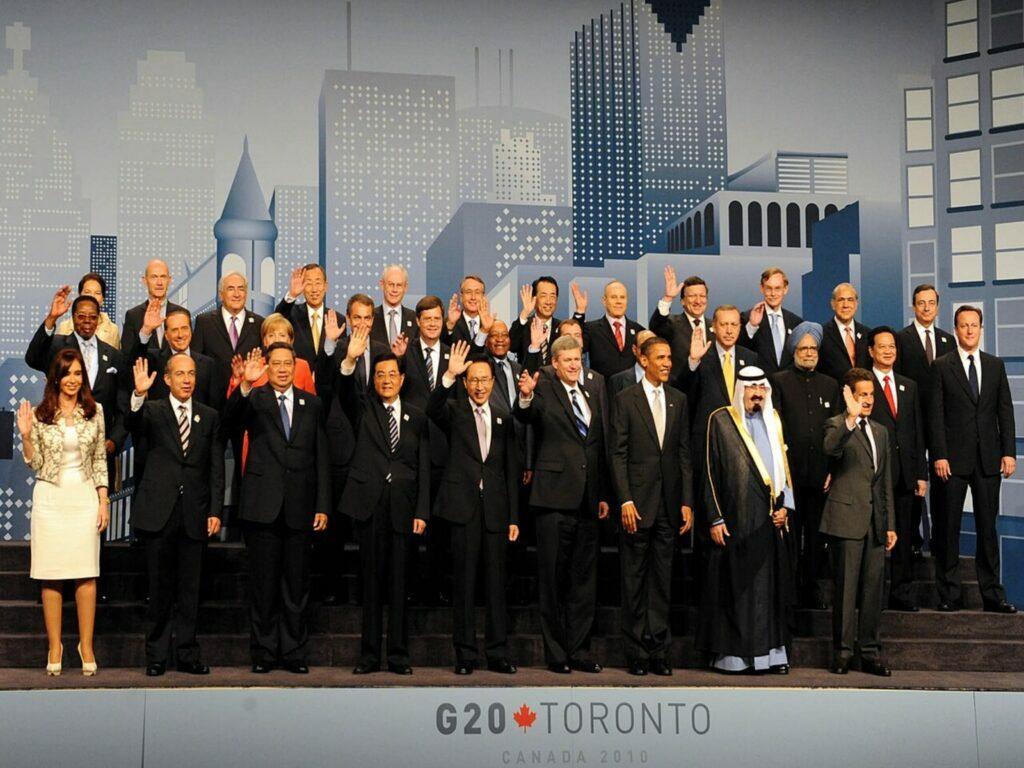
On May 8, 2010, Stephen Harper released a list of summit attendees for the meeting in Toronto. To supplement South Africa’s representation of Africa at the G20, Harper invited the leaders of Ethiopia and Malawi. Not only did he invite the Dutch and Spanish governments, but also those of Vietnam and Nigeria.
Delegates to the G8 and G20 meetings entered Canada through Toronto Pearson International Airport. The G20 leaders that arrived first were Nicolas Sarkozy of France and Hu Jintao of China. Hu was welcomed to Canada by Governor General Michalle Jean in Ottawa as part of his state visit. On June 24, Presidents Goodluck Jonathan of Nigeria and Jacob Zuma of South Africa arrived. On June 25, Canadians welcomed British Prime Minister David Cameron during his brief stop in Halifax for the Canadian Forces Maritime Command’s centennial celebrations. The day also saw the arrival of the remaining G8 leaders.
First-timers at the G20 meeting were the International Labor Organization, the Organization for Economic Co-operation and Development, Ethiopia, Malawi, Nigeria, and Vietnam. Cameron and Naoto Kan, the prime minister of Japan, were among the world leaders who attended their first international conferences as G8 and G20 leaders, respectively. Wayne Swan, Australia’s deputy prime minister, represented Julia Gillard, who was appointed prime minister on June 24, during the meeting. Brazil’s president, Luiz Inácio Lula da Silva, decided to stay home because of the recent floods in the country’s northeast; thus, the country’s finance minister, Guido Mantega, led the Brazilian delegation in his stead. Cameron’s plane was stranded due to weather, so he rode with Obama in Marine One from Huntsville, Ontario, to Toronto after the G8 summit concluded.
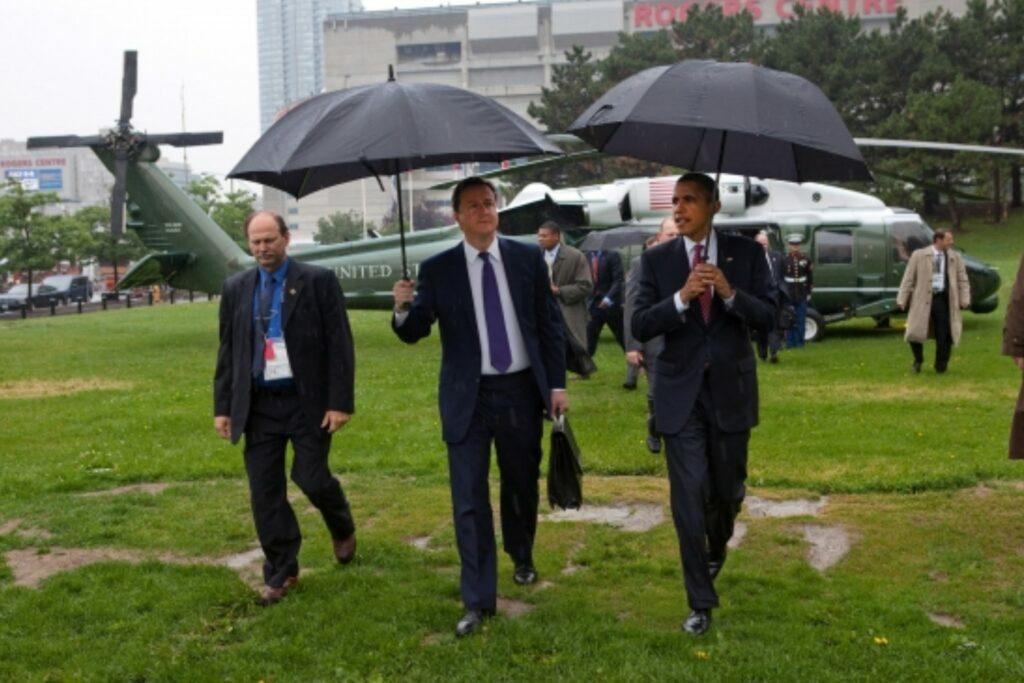
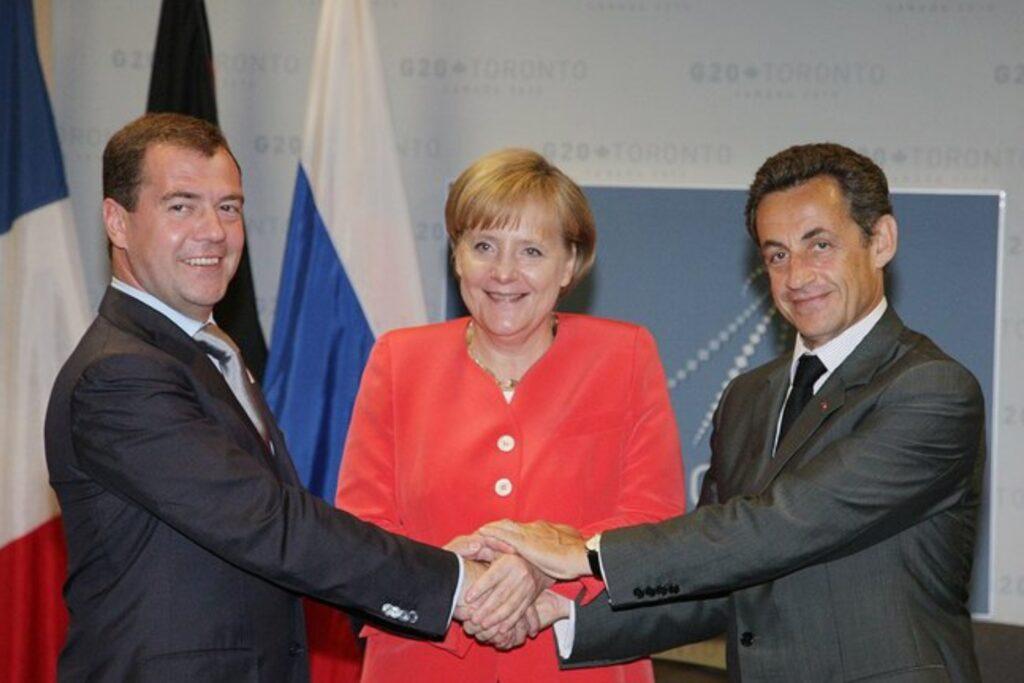
Dmitry Medvedev shaking hands with Angela Merkel and Nicolas Sarkozy
| G20 Members Host nation and lender are indicated in bold text | |||
| Member | Represented by | Title | |
| 🇦🇷 | Argentina | Cristina Fernández de Kirchner | President |
| 🇦🇺 | Australia | Wayne Swan | Deputy Prime Minister |
| 🇧🇷 | Brazil | Guido Mantega | Finance Minister |
| 🇨🇦 | Canada | Stephen Harper | Prime Minister |
| 🇨🇳 | People’s Republic of China | Hu Jintao | President and General Secretary |
| 🇫🇷 | France | Nicolas Sarkozy | President |
| 🇩🇪 | Germany | Angela Merkel | Chancellor |
| 🇮🇳 | India | Manmohan Singh | Prime Minister |
| 🇮🇩 | Indonesia | Susilo Bambang Yudhoyono | President |
| 🇮🇹 | Italy | Silvio Berlusconi | Prime Minister |
| 🇯🇵 | Japan | Naoto Kan | Prime Minister |
| 🇲🇽 | Mexico | Felipe Calderón | President |
| 🇷🇺 | Russian Federation | Dmitry Medvedev | President |
| 🇸🇦 | Saudi Arabia | Abdullah bin Abdul Aziz | King |
| 🇿🇦 | South Africa | Jacob Zuma | President |
| 🇰🇷 | Republic of Korea (South Korea) | Lee Myung-bak | President |
| 🇹🇷 | Turkey | Recep Tayyip Erdoğan | Prime Minister |
| 🇬🇧 | United Kingdom | David Cameron | Prime Minister |
| 🇺🇸 | United States | Barack Obama | President |
| 🇪🇺 | European Commission | José Manuel Barroso | President |
| European Council | Herman Van Rompuy | President | |
| Invited Nations | |||
| Nations | Represented by | Title | |
| 🇪🇹 | Ethiopia | Meles Zenaw | Prime Minister |
| 🇲🇼 | Malawi | Bingu wa Mutharika | President |
| 🇳🇱 | Netherlands | Jan Peter Balkenende | Prime Minister |
| 🇳🇬 | Nigeria | Goodluck Jonathan | President |
| 🇪🇸 | Spain | José Luis Rodríguez Zapatero | Prime Minister |
| 🇻🇳 | Vietnam | Nguyễn Tấn Dũng | Prime Minister |
| International Organisations | |||
| Organisations | Represented by | Title | |
| African Union | Bingu wa Mutharika | Chairperson | |
| ASEAN | Surin Pitsuwan | Secretary General | |
| Nguyễn Tấn Dũng | Summit President | ||
| Financial Stability Board | Mario Draghi | Chairman | |
| International Labour Organization | Juan Somavía | Director-General | |
| International Monetary Fund | Dominique Strauss-Kahn | Managing Director | |
| NEPAD | Meles Zenawi | Chairman | |
| OECD | José Ángel Gurría | Secretary General | |
| 🇺🇳 | United Nations | Ban Ki-moon | Secretary General |
| World Bank Group | Robert Zoellick | President | |
| World Trade Organization | Pascal Lamy | Director-General | |
Protests
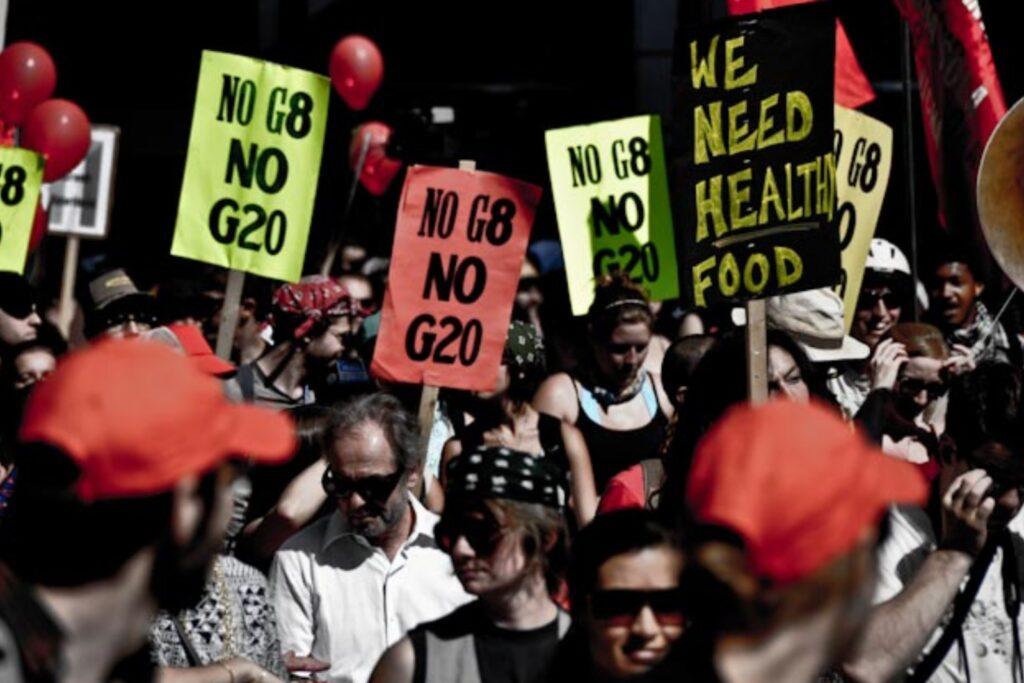
Along with smaller protests in downtown Toronto during the week before the summit, the level of violence suddenly rose during the summit days. Early opposition to the G20 included anarchists setting fire to a bank in Ottawa because they said they would be there for the G20 meeting in Toronto. The Integrated Security Unit lifted security measures because they saw a threat to safety.
Groups like Oxfam Canada and the Ontario Coalition Against Poverty planned protests that started a week before the summit. People protested over things like poverty, gay rights, capitalism and globalization, indigenous rights, and controversial problems with the summit itself. Although some people were arrested, most of the protests this week were deemed harmless.
Protesters got more numerous as the summit’s first day got closer. Multiple streets were blocked off to protesters on the first day of the meeting. People wearing black broke out of the crowd of peaceful protesters and started breaking the windows of some downtown Toronto businesses, mostly fast food chains, shops, banks, and some smaller local businesses. People set fire to police cars and damaged the vehicles of media companies. Healthcare facilities, shopping malls, and hotels nearby were locked down, and public transportation was rerouted from downtown to other areas.
The next day, security was tightened even more, and more police were stationed. Protests against police brutality happened in front of the Eastern Avenue temporary detention center, where about 500 people caught during the previous day’s riots were being held and later released. People who were protesting were also “kettled” for about four and a half hours, during which time it rained very hard because black bloc protesters were thought to be in the crowd. This week, more than 1,100 people were officially jailed. Widespread arrests were made by the ISU within a certain distance of the peak site. Individuals who were arrested during the protests spoke out against how the cops treated them.
Overall, a constable was found guilty of assaulting a protester, and a superintendent was found guilty of unlawful arrest and dishonest conduct for ordering the “kettling” events. They were both given hypothetical punishments but kept their jobs as police officers. There were times when things were not handled the way they should have been, and many hundreds of members of the public were detained or arrested when they should not have been and were held in detention in conditions that were unacceptable,” the Toronto police admitted in October 2020, more than a decade after the summit. They decided to pay $16.5 million to support a thousand people they wrongfully detained or arrested in different situations.
Outcome
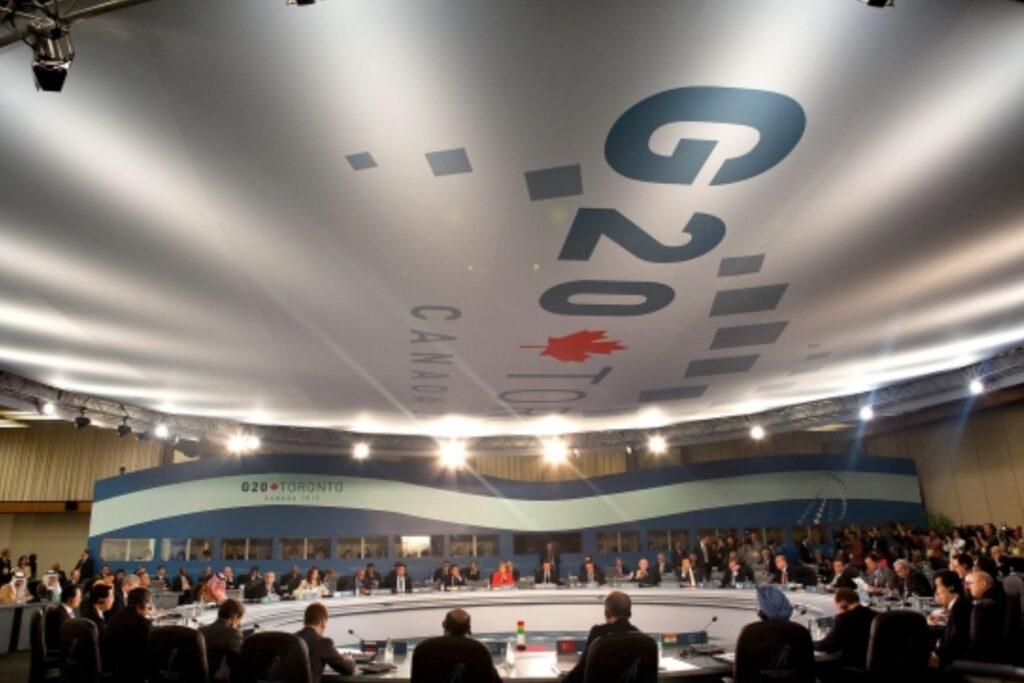
A lot of people were hoping that the Toronto summit wouldn’t end up like the others had. This was partly because most countries had begun to recover from the global economic recession after the previous G20 summits, reducing the probability that any fresh issues would be highlighted.
South African President Jacob Zuma advocated for further international cooperation with Africa during a working dinner for G20 leaders on the evening of June 26. “As Africa, we bring to the G20 Summit the key message that we must, together as the developing and developed worlds, promote stronger, more effective, and equal international partnerships for growth and development,” he pointed out.
U.S. President Barack Obama said at the meeting that the global economic recovery was still “fragile.” To increase U.S. exports, he advocated for a free trade deal between the two countries. The leaders of industrialized countries agreed, among other things, to halve their annual budget deficits by 2013. The leaders also pledged to lower their respective debt-to-GDP ratios by 2016. The issue of whether or not to tax financial institutions was settled when the group decided that such institutions would be expected to make fair contributions to recoup costs from the reform of the financial sector but that the method of collecting such contributions would be left up to individual governments. Participants also agreed that institutions would be forced to set aside more money as capital in the event of a financial shock in the future. Additionally, the leaders reaffirmed their dedication to “greener growth” and emphasized climate change and food security.
Shortly after the conclusion of the G20 Toronto Summit, a declaration was issued stating that “serious challenges remain.” The statement cites high unemployment rates across economies and the continuing effects of the financial crisis as two of the obstacles. In its post-summit paper, the International Monetary Fund warned that hasty efforts to reduce deficits could severely hamper economic expansion. The group said in a report titled Top Ten Commandments for Fiscal Adjustment in Advanced Economies that stable bond markets, lower interest rates due to reduced government spending, and increased private investment could all result from a more fiscally responsible public sector. It also suggested that rising economies like China’s, which has greatly benefited from trade surpluses, reduce their reliance on Western nations and raise their own expenditures to boost domestic demand.
Criticism
Financial costs
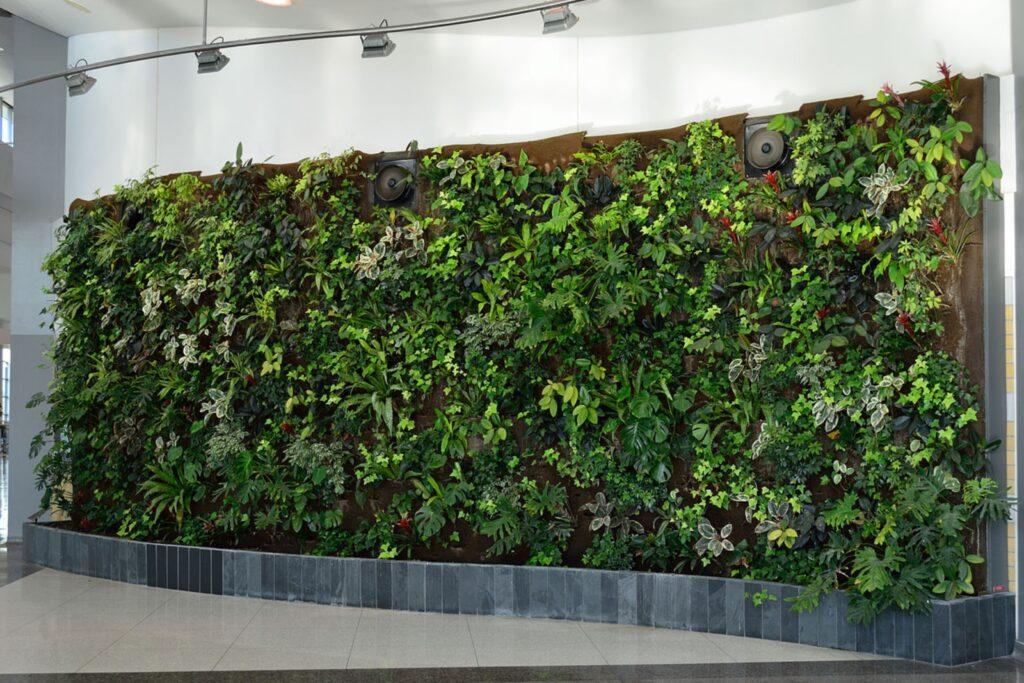
Several political arguments and criticisms from local groups were about how much it cost to host the G8 and G20 summits. Some lawmakers and local groups were curious about why the costs for both summits were so high. The original budget of $1.1 billion for holding the summits was called “obscene” and “insane” by Members of Parliament Olivia Chow and Mark Holland. Other people said that the money could have been used for long-overdue municipal projects in Canada, like Transit City. It was thought that the cost of security for the two meetings would be higher than the $878 million cost of security for the 2010 Winter Olympics and Paralympics in Vancouver and Whistler, British Columbia. However, the House of Commons of Canada’s final numbers as of October 2010 show that the exact cost of having both summits was $857,901,850.31. This is less than what it cost to secure the 2010 Winter Olympics.
It was first said that the summits were the most expensive ever, with only $30 million and $18 million spent on security for the London and Pittsburgh meetings, respectively. But Kevin Page, the Canadian Parliamentary Budget Officer, wrote in his official report about how much the Huntsville and Toronto meetings cost that other countries had not been as open about how much similar meetings cost in those places. He also said that the $18 million number for the Pittsburgh summit was only for overtime pay for local police and the cost of bringing in police from other areas. According to Ward Elcock, who used to be the head of the Canadian Security Intelligence Service and the Integrated Security Units for the Winter Olympics and the G8/G20 summits, the costs of security were “comparable” to those of earlier summits. The cost of security was defended by Jim Flaherty, the finance minister, who said, “It’s necessary to spend substantially to have security.” It’s Canada’s turn, and we need to either wait our turn or pay the right amount to have the safety measures we need to keep everyone safe here in Toronto.
Many people were against building the $23 million international media center at Exhibition Place. It included the $1.9 million Experience Canada tower and the $57,000 man-made lake. Politicians called it “a waste of taxpayers’ money.” Most of the criticism was aimed at Stephen Harper and Canada’s Conservative government. Some protesters gave the man-made lake names, like “Harper’s Folly.” Member Mark Holland of the House of Commons said during a discussion, “Maybe the government should plan a party for Lady Gaga instead of hosting world leaders.” Critics say that the money spent on the summits went off track and was used to promote Canada’s qualities instead of the summits’ goals. Jack Layton, head of the New Democratic Party, said, “We have a government that has to build an artificial lake when Canada already has more lakes than almost any other country in the world.” Individuals who pay taxes will be the ones who sink to the bottom of the fake lake. John Baird, Canada’s minister of transportation, supported the man-made lake by saying that the summits were a “chance to showcase the very best that [Canada] has to offer.” Foreign Affairs Minister Lawrence Cannon said it was “normal practice” for a country that hosts a world event to show off its best features. Harper said, “This is a classic attempt for us to be able to market the country.” during his defense. When the man-made lake first opened, it got mostly bad reviews from Canadian media.
Economic impact
Few local politicians and residents were particularly worried about the summit’s potential financial impact. Before, the Metro Toronto Convention Centre, located in the heart of the city’s financial district, was seen as an undesirable location for the G20 summit by the Toronto municipal administration and certain public representatives. The mayor of Toronto, David Miller, called on the federal government to reimburse the city for the damage done to businesses and properties during the summit protests. Damages to companies outside of the security zone would not be covered, as was originally stated by the government. All the destruction, however, occurred beyond the perimeter. Some downtown establishments experienced financial difficulties as a result. To John McCallum, a member of parliament: “Stephen Harper made a huge mistake in holding this summit in downtown Toronto.” The Toronto Star reports that up to $750,000 in repairs were made by a single repair company after at least 40 establishments in the Downtown Yonge Business Improvement Area were damaged.
International response
On June 17, the US Department of State sent out a travel alert for Toronto, telling tourists that the G20 meeting would likely cause traffic problems and possibly violent protests. It said that “even demonstrations that are meant to be peaceful can become violent and unpredictable.” The alert was set to expire on the last day of the summit. As Mayor of Toronto David Miller put it, the warning was “overreaction.”
During the meeting, a few reporters from other countries talked about Canada and the summits. There were positive things said about Canada’s economy by a BBC reporter, who said, “The Canadians, it seems, have answers for even the toughest puzzles, and they are eager to share their strategies with the rest of the world.” In this market, we all want to be Canadian. A writer in The New York Times said nice things about how the summits were planned and how beautiful the Muskoka area is. Both The Times of India and The Hindu wrote about how the G20 meeting changed city life in Toronto and the “unprecedented” security steps that were taken in Canada. One Reuters writer, on the other hand, said that the international media center’s man-made lake was bad.
Nicolas Sarkozy, the president of France, said that the costs of holding the planned 2011 G20 Cannes summit and the 37th G8 summit in France would be one-tenth of those in Canada.
Read also :